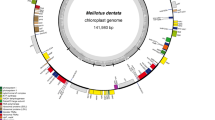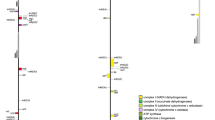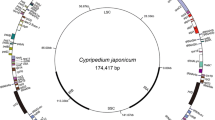Abstract
In plants, mitochondrial sequence tandem repeats (STRs) have been associated with intragenomic recombination, a process held responsible for evolutionary outcomes such as gene regulation or cytoplasmic male-sterility. However, no link has been established between the recurrent accumulation of STRs and increased mutation rates in specific regions of the plant mtDNA genome. Herein, we surveyed this possibility by comparing, in a phylogenetic context, the variation of a STR-rich mitochondrial intron (nad5-4) with eleven mtDNA genes devoid of STRs within Abies (Pinaceae) and its related genera. This intron has been accumulating repeated stretches, generated by at least three-independent insertions, before the split of the two Pinaceae subfamilies, Abietoideae and Pinoideae. The last of these insertions occurred before the divergence of Abies and produced, exclusively within this genus, a tenfold increase of both the indel and substitution rates in the STR hotspot of the intron. The regions flanking the STRs harbored mutation rates as low as those estimated in mitochondrial genes devoid of repeated stretches. Further searches in complete plant mtDNA genomes, and previous studies reporting polymorphic mtSTRs, revealed that repeated stretches are common in all sorts of plants, but their accumulation in STR hotspots appears to be taxa specific. Our study suggests a new mutagenic role for repeated sequences in the plant mtDNA.




Similar content being viewed by others
References
Aguirre-Planter E, Jaramillo-Correa JP, Gómez-Acevedo S et al (2012) Phylogeny, diversification rates and species boundaries of Mesoamerican firs (Abies, Pinaceae) in a genus-wide context. Mol Phyl Evol 62:263–274
Allen JO, Fauron CM, Minx P et al (2007) Comparison among two fertile and three male-sterile mitochondrial genomes in maize. Genetics 177:1173–1192
Alverson AJ, Wei X-X, Rice DW et al (2010) Insights into the evolution of mitochondrial genome size from complete sequences of Citrullus lanatus and Cucurbita pepo (Cucurbitaceae). Mol Biol Evol 27:1436–1448
Amos W, Flint J, Xu X (2008) Heterozygosity increases microsatellite mutation rate, linking it to demographic history. BMC Genet 9:72. doi:10.1186/1471-2156-9-72
Barr CM, Neiman M, Taylor DR (2005) Inheritance and recombination of mitochondrial genomes in plants, fungi and animals. New Phytol 168:39–50
Barros P, Blanco MG, Boán F, Gómez-Márquez J (2008) Evolution of a complex minisatellite sequence. Mol Phyl Evol 49:488–494
Bastien D, Favre JM, Collington AM et al (2003) Characterization of a mosaic minisatellite locus in the mitochondrial DNA of Norway spruce [Picea abies (L.) Karst.]. Theor Appl Genet 107:574–580
Benson G (1999) Tandem repeats finder: a program to analyze DNA sequences. Nucl Acids Res 27:573–580
Bonen L (2008) Cis- and trans-splicing of group II introns in plant mitochondria. Mitochondrion 8:26–34
Bouillé M, Bousquet J (2005) Trans-species shared polymorphisms at orthologous nuclear gene loci among distant species in the conifer Picea (Pinaceae): implications for the long-term maintenance of genetic diversity in trees. Am J Bot 92:63–73
Boussau B, Brown JM, Fujita MK (2011) Nonadaptive evolution of mitochondrial genome size. Evolution 65:2706–2711
Broughton RE, Dowling TE (1997) Evolutionary dynamics of tandem repeats in the mitochondrial DNA control region of the minnow Cyprinella Spiloptera. Mol Biol Evol 14:1187–1196
Buschiazzo E, Gemmell NJ (2006) The rise, fall and renaissance of microsatellites in eukaryote genomes. BioEssays 28:1040–1050
Carrillo C, Chapdelaine Y, Bonen L (2001) Variation in sequence and RNA editing within core domains of mitochondrial group II introns among plants. Mol Gen Genet 264:595–603
Chaw SM, Shih AC-C, Wang D et al (2008) The mitochondrial genome of the gymnosperm Cycas taitungensis contains a novel family of short interspersed elements, Bpu sequences, and abundant RNA editing sites. Mol Biol Evol 25:603–615
Chen X, Cho YG, McCouch SR (2002) Sequence divergence of rice microsatellites in Oryza and other plant species. Mol Genet Genomics 268:331–343
Cho Y, Mower JP, Qiu Y-L, Palmer JD (2004) Mitochondrial substitution rates are extraordinarily elevated and variable in a genus of flowering plants. Proc Natl Acad Sci USA 101:17741–17746
Dumolin-Lapègue S, Pemonge M-H, Petit RJ (1997) An enlarged set of consensus primers for the study of organelle DNA in plants. Mol Ecol 6:393–397
Farjon A, Rushforth KD (1989) A classification of Abies Miller (Pinaceae). Notes of the Royal Botanical Gardens Edinburgh 46:59–79
Gaut BS, Le Tierry d’Ennequin M, Peek AS, Sawkins MC (2000) Maize as a model for the evolution of plant nuclear genomes. Proc Natl Acad Sci USA 97:7008–7015
Gemayel R, Vinces MD, Legendre M, Verstrepen KJ (2010) Variable tandem repeats accelerate evolution of coding and regulatory sequences. Annu Rev Genet 44:445–477
Gernandt DS, Magallón S, López GG et al (2008) Use of simultaneous analyses to guide fossil-based calibrations of Pinaceae phylogeny. Int J Plant Sci 169:1086–1099
Godbout J, Jaramillo-Correa JP, Beaulieu J, Bousquet J (2005) A mitochondrial DNA minisatellite reveals the postglacial history of jack pine (Pinus banksiana), a broad-range North American conifer. Mol Ecol 14:3497–3512
Godbout J, Fazekas A, Newton CH, Yeh FC, Bousquet J (2008) Glacial vicariance in the Pacific Northwest: evidence from a lodgepole pine mitochondrial DNA minisatellite for multiple genetically distinct and widely separated refugia. Mol Ecol 17:2463–2475
Gugerli F, Sperisen C, Büchler U et al (2001) The evolutionary split of the Pinaceae from other conifers: evidence from an intron loss and a multigene phylogeny. Mol Phyl Evol 21:167–175
Hall TA (1999) BioEdit: a user-friendly biological sequence alignment editor and analysis program for Windows95/98/NT. Nucl Acid Symp Ser 41:95–98
Hecht J, Grewe F, Knoop V (2011) Extreme RNA editing in coding islands and abundant microsatellites in repeat sequences of Selaginella moellendorffii mitochondria: the root of frequent plant DNA recombination in early Tracheophytes. Genome Biol Evol 3:344–358
Honma Y, Yoshida Y, Terachi T et al (2011) Polymorphic minisatellites in the mitochondrial DNAs of Oryza and Brassica. Curr Genet 4:261–270
Ishii T, Takahashi C, Ikeda N et al (2006) Mitochondrial microsatellite variability in common wheat and its ancestral species. Genes Genet Syst 81:211–214
Jackobson M, Sáll T, Lind-Halldén C, Halldén C (2007) Evolution of chloroplast mononucleotide microsatellites in Arabidopsis thaliana. Theor Appl Genet 114:223–235
Jaramillo-Correa JP, Bousquet J (2005) Mitochondrial genome recombination in the zone of contact between two hybridizing conifers. Genetics 171:1951–1962
Jaramillo-Correa JP, Bousquet J, Beaulieu J et al (2003) Cross-species amplification of mitochondrial DNA sequence-tagged-site markers in conifers: the nature of polymorphism and variation within and among species in Picea. Theor Appl Genet 106:1353–1367
Jaramillo-Correa JP, Aguirre-Planter E, Khasa DP et al (2008) Ancestry and divergence of subtropical montane forest isolates: molecular biogeography of the genus Abies (Pinaceae) in southern México and Guatemala. Mol Ecol 17:2476–2490
Jaramillo-Correa JP, Grivet D, Terrab A et al (2011) The Strait of Gibraltar as a major phylogeographic barrier in Mediterranean conifers: a comparative phylogeographic survey. Mol Ecol 19:5452–5468
Jiang Z-Y, Peng Y-L, Hu X-X et al (2011) Cytoplasmic DNA variation and genetic delimitation of Abies nephrolepis and Abies holophylla in northeastern China. Can J For Res 41:1555–1561
Karhu A, Dieterich J-H, Savolainen O (2000) Rapid expansion of microsatellite sequences in pines. Mol Biol Evol 17:259–265
Kelchner SA (2002) Group II introns as phylogenetic tools: structure, function, and evolutionary constraints. Am J Bot 89:1651–1669
Laroche J, Bousquet (1999) Evolution of the mitochondrial rps3 intron in perennial and annual angiosperms and homology with nad5 intron I. Mol Biol Evol 16:441–452
Laroche J, Li P, Maggia L, Bousquet J (1997) Molecular evolution of angiosperm mitochondrial introns and exons. Proc Natl Acad Sci USA 94:5722–5727
Librado P, Rozas J (2009) DnaSP v5: a software for comprehensive analysis of DNA polymorphism data. Bioinformatics 25:1451–1452
Liepelt S, Bialozyt R, Ziegenhagen B (2002) Wind-dispersed pollen mediates postglacial gene flow among refugia. Proc Natl Acad Sci USA 99:14590–14594
Liepelt S, Mayland-Quellhorst E, Lehme M, Ziegenhangen B (2010) Contrasting geographical patterns of ancient and modern genetic lineages in Mediterranean Abies species. Plant Syst Evol 284:141–151
Lilly JW, Harvey MJ (2001) Small, repetitive DNAs contribute significantly to the expanded mitochondrial genome of cucumber. Genetics 159:317–328
Lin C-P, Huang J-P, Wu C-S et al (2010) Comparative chloroplast genomics reveals the evolution of Pinaceae genera and subfamilies. Genome Biol Evol 2:504–517
Liu T-S (1971) A monograph of the genus Abies. Dissertation, National Taiwan University, Taipei
Löhne C, Borsch T (2005) Molecular evolution and phylogenetic utility of the petD group II intron: a case study in basal angiosperms. Mol Biol Evol 22:317–332
Lynch M, Conery JS (2003) The origins of genome complexity. Science 302:1401–1404
Maddison WP, Maddison DR (2011) Mesquite: a modular system for evolutionary analysis, version 2.75. http://mesquiteproject.org
McDonald MJ, Wand W-C, Huang H-D, Leu J-Y (2011) Clusters of nucleotide substitutions and insertion/deletion mutations are associated with repeat sequences. PLoS Biol 9:e1000622. doi:10.1371/journal.pbio.1000622
Mitton JB, Kreiser BR, Rehfeldt GE (2000) Primers designed to amplify a mitochondrial nad1 intron in Ponderosa pine, Pinus ponderosa, limber pine, P. flexilis, and Scotts pine, P. sylvestris. Theor Appl Genet 101:1269–1272
Morgante M (2006) Plant genome organisation and diversity: the year of the junk! Curr Opin Biotech 17:168–173
Morgante M, Hanafey M, Powell W (2002) Microsatellites are preferentially associated with nonrepetitive DNA in plant genomes. Nature Genet 30:194–200
Morse AM, Peterson DG, Islam-Faridi MN et al (2009) Evolution of genome size and complexity in Pinus. PLoS ONE 4:e4332
Mouhamadou B, Férandon C, Chazoule S, Barroso G (2007) Unusual accumulation of polymorphic microsatellite loci in a specific region of the mitochondrial genome of two mushroom-forming Agrocybe species. FEMS Microbiol Lett 272:276–281
Mower JP, Touzet P, Gummow JS et al (2007) Extensive variation in synonymous substitution rates in mitochondrial genes of seed plants. BMC Evol Biol 7:135
Nishizawa S, Kubo T, Mikami T (2000) Variable number of tandem repeat loci in the mitochondrial genome of beets. Curr Genet 37:34–38
Nybom H (2004) Comparison of different nuclear DNA markers for estimating intraspecific genetic diversity in plants. Mol Ecol 13:1143–1155
Ogihara Y, Yamazaki Y, Murai K et al (2005) Structural dynamics of cereal mitochondrial genomes as revealed by complete nucleotide sequencing of the wheat mitochondrial genome. Genetics 33:6235–6250
Palmer JD, Adams KL, Cho Y et al (2000) Dynamic evolution of plant mitochondrial genomes: mobile genes and introns and highly variable mutation rates. Proc Natl Acad Sci USA 97:6960–6966
Peng Y, Yi S, Wang J et al (2012) Phylogeographic analysis of the fir species in southern China suggests complex origin and genetic admixture. Ann For Sci 69:409–416
Petit RJ, Hampe A (2006) Some evolutionary consequences of being a tree. Annu Rev Ecol Evol Syst 37:187–214
Polezhaeva MA, Lascoux M, Semerikov VL (2010) Cytoplasmic DNA variation and biogeography of Larix Mill. in Northeast Asia. Mol Ecol 19:1239–1252
Primer CR, Ellegren H (1998) Patterns of molecular evolution in avian microsatellites. Mol Biol Evol 15:997–1008
Ran J-H, Gao H, Wang X-Q (2010) Fast evolution of the retroprocessed mitochondrial rps3 gene in conifer II and further evidence for the phylogeny of gymnosperms. Mol Phyl Evol 54:136–149
Rushforth KD (1989) Two new species of Abies (Pinaceae) from western México. Notes Roy Bot Gard Edinburgh 46:101–109
Semerikova SA, Semerikov VL, Lascoux M (2011) Post-glacial history and introgression in Abies (Pinaceae) species of the Russian Far East inferred from both nuclear and cytoplasmic markers. J Biogeo 38:326–340
Sperisen C, Büchler U, Gugerli F et al (2001) Tandem repeats in plant mitochondrial genomes: application to the analysis of population differentiation in the conifer Norway spruce. Mol Ecol 10:257–263
Swigoňová Z, Lai J, Ma J et al (2004) Close split of Sorghum and maize genome progenitors. Genome Res 14:1916–1923
Tajima F (1983) Evolutionary relationship of DNA sequences in finite populations. Genetics 105:437–460
Thuiller A-C, Bru D, David J et al (2002) Direct estimation of mutation rate for 10 microsatellite loci in Durum wheat, Triticum turgidum (L.) Thell. ssp. durum desf. Mol Biol Evol 19:122–125
Vázquez-Lobo A (1996) Evolución de hongos endófitos del género Pinus. Tesis de licenciatura, Facultad de Ciencias, Universidad Nacional Autónoma de México, México, DF
Vergnaud G, Denoeud F (2000) Minisatellites: mutability and genome architecture. Genome Res 10:899–907
Victoria FC, da Maia LC, Costa de Oliveira A (2011) In silico comparative analysis of SSR markers in plants. BMC Plant Biol 11:15
Wang Z, Weber JL, Zhong G, Tanksley SD (1994) Survey of plant short tandem DNA repeats. Theor Appl Genet 88:1–6
Wang J, Abbot RJ, Peng YL et al (2011) Species delimitation and biogeography of two fir species (Abies) in central China: cytoplasmic DNA variation. Heredity 107:362–370
Watterson GA (1975) On the number of segregating sites in genetical models without recombination. Theor Pop Biol 7:256–276
Wilkinson GS, Mayer F, Kerth G, Petri B (1997) Evolution of repeated sequence arrays in the D-loop region of bat mitochondrial DNA. Genetics 146:1035–1048
Woloszynska M, Kieleczawa J, Ornatowska M et al (2001) The origin and maintenance of small repeats in the bean mitochondrial genome. Mol Genet Genomics 265:865–872
Xiang Q-P, Xiang Q-Y, Guo Y-Y, Zhnag X-C (2009) Phylogeny of Abies (Pinaceae) inferred from nrITS sequence data. Taxon 58:141–152
Zar JH (2010) Biostatistical analysis, 5th edn. Prentice Hall, Upper Saddle River
Zhu Y, Queller DC, Strassmann JE (2000) A phylogenetic perspective on sequence evolution in microsatellite loci. J Mol Evol 50:324–338
Ziegenhagen B, Fady B, Kuhlenkamp V, Liepelt S (2005) Differentiating groups of Abies species with a simple molecular marker. Silvae Genet 54:123–126
Acknowledgments
We are grateful to J. Beaulieu, I. Gamache (Canadian Forest Service), C. Sayre (VanDusen Botanical Garden), F.T. Ledig (Univ. California-Davis), S.C. González-Martínez (CIFOR-INIA), P. Delgado, D. Gernandt, A. Keiman, Y. Nava, C. Saenz, and Glenn R. Furnier (Insts. of Biology and Ecology-UNAM) for valuable help during sample collections, and to S. Senneville, S. Gerardi (Univ. Laval), K. Budde, Y. Kurt, and M. Zabal (CIFOR-INIA) for assistance in the laboratory. Further thanks are extended to B. Morton, P. Canard and two anonymous reviewers for constructive comments on a previous draft of this manuscript. This research was financially supported by grants from the Ministère du développement économique de l’innovation et de l’exportation of Québec, the Natural Sciences and Engineering Research Council of Canada (Discovery program), the Consejo Nacional de Ciencia y Tecnología (CONACYT, Grants 153305 and 167826), the Comisión Nacional para el Conocimiento y el uso de la Biodiversidad (CONABIO, grant B138), and the Programa de Apoyo a las Divisiones de Estudios de Postgrado (PADEP-UNAM) and the Dirección General de Asuntos del Personal Académico (IN224309-3, IN202712 and IC200411) from the Universidad Nacional Autónoma de México.
Author information
Authors and Affiliations
Corresponding author
Electronic supplementary material
Below is the link to the electronic supplementary material.
Rights and permissions
About this article
Cite this article
Jaramillo-Correa, J.P., Aguirre-Planter, E., Eguiarte, L.E. et al. Evolution of an Ancient Microsatellite Hotspot in the Conifer Mitochondrial Genome and Comparison with Other Plants. J Mol Evol 76, 146–157 (2013). https://doi.org/10.1007/s00239-013-9547-2
Published:
Issue Date:
DOI: https://doi.org/10.1007/s00239-013-9547-2




